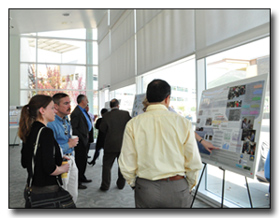Archive Report
3rd North American Materials Education Symposium, 2012
Cal Poly, San Luis Obispo
March 29-30, 2012
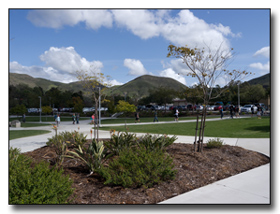 Views on campus at Cal Poly. |
|
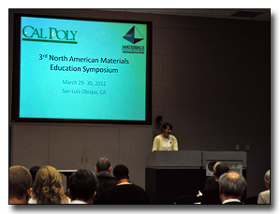 Deborah Larson, Dean of the College of Engineering at Cal Poly, opens the 3rd North American Materials Education Symposium. |
|
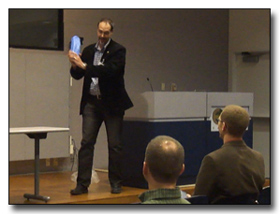 John Nychka (University of Alberta) showing a block of Silly PuttyTM in its new defined usage for materials teaching. This versatile low-cost material provides hands-on activities for teaching a wide range of concepts. |
|
 John Stolk (Olin College of Engineering) and Linda Vanasupa's (Cal Poly) interactive workshop fired enthusiasm, and provided practical tips for attendees to take back to their classes. |
|
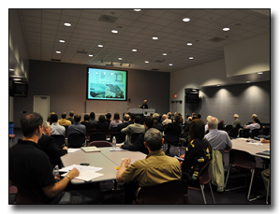 Over 60 educators enjoyed presentations and discussions. |
|
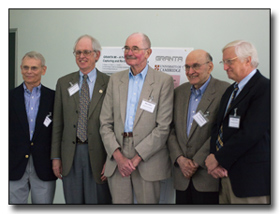 Mike Ashby (center) joined other leading materials educators in sharing resources and experiences. |
|
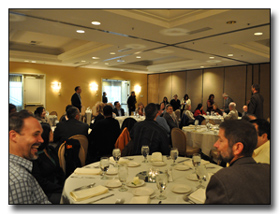 Discussions continued into the evening. |
The 3rd North American Materials Education Symposium was attended by over 60 educators, who gathered in the beautiful setting of Cal Poly, San Luis Obispo. Presentations and posters covered a wide range of topics related to materials and processes across engineering, science, and design. The two-days of talks were divided into four sessions:
- Engaging students
- Advanced teaching, research, and industry
- Architecture and design
- Crossing disciplines
The Symposium provided a collaborative atmosphere for discussion on all of these topics. The social program, taking place near the campus and around San Luis Obispo, made the event interactive, with plenty of opportunities to meet people and exchange ideas. On the night before the Symposium, the speakers gathered for a dinner at Dairy Creek Golf course, getting the discussions off to an early start and setting a collaborative tone for the event. After the first day, attendees had dinner at the nearby Cliffs Resort in Pismo Beach; both socializing and discussion from the day’s sessions spilled over well into the night.
Symposium Report
Day One:
'Engaging Students'
and
'Advanced Teaching, Research, and Industry'
The Symposium was officially opened by Deborah Larson, Dean of the College of Engineering at Cal Poly. She encouraged discussion from the very beginning, pointing out that change will happen and lead to accumulated materials development. This will reshape both industrial and higher education careers, as new disciplines and inter-disciplines are formed. She spoke about how this will affect engineering and education in particular. This future will require new processes, new materials, and new products, all based on innovation. Such innovation is a learning process that can be taught: "we learn, we do, we innovate". Trevor Harding commented further: "innovation is about a community."
The first session, chaired by Trevor Harding (Cal Poly), focused on Engaging Students. It offered a stimulating set of talks drawing on a wide range of experiences. Visual, hands-on, and even food based teaching approaches were demonstrated with great enthusiasm. Discussions also looked at how important it is to understand the prior knowledge of students when planning teaching, and the challenge of promoting depth of studies. There was general consensus that teachers should think more of students than particular methods, and adapt these approaches accordingly.
A new innovation at this year's Symposium, the Designing Learning Experiences Workshop, allowed attendees to gain some additional experience of alternative teaching approaches—this generated a great deal of discussion. John Stolk (Olin College of Engineering) and Linda Vanasupa's (Cal Poly) activities certainly enhanced the motivation and well-being of attendees while revealing the impact of hidden assumptions on engagement. Discussions highlighted how course design for success is a narrow path, and 'scaffolding' self-teaching can allow improved autonomy and more meaningful learning for students.
The afternoon session on Advanced Teaching, Research, and Industry, chaired by Mark De Guire (Case Western Reserve University), provided insights on future paradigm shifts for academic curricula, mainly influenced by the Materials Genome Initiative. With the aim of accelerating the time it takes from a material being discovered to use in an application, the changes promoted by the Initiative will need academics, educators, engineers, and multidiscipline / multiagency partnerships. An interesting discussion point was the role of online distance learning in this area.
Day Two:
'Architecture and Design' and
'Crossing Disciplines'
The collaborative atmosphere established on day one continued as attention focused on Architecture and Design in the session chaired by James Doerfler (Cal Poly). There is growing emphasis on 'deep understanding' of the materials used for built environments. Attendees heard how students need to appreciate the importance of rigorous materials selection, especially given the continuing focus of architectural design on ‘material novelty’. This prompted discussion on materials consumption and how to keep students motivated about sustainability issues within architectural design. John Abelson (University of Illinois) looked at the learning opportunities and challenges of carrying out a whole-class project, such as selecting construction options for a zero-net annual energy home. Delegates also heard, from Sydney Mainster (University of Texas at Austin) about the use of large materials collections as a tool to promote education in advanced and interdisciplinary materials construction, design, research, and development.
As on day one, delegates were open to changing their teaching style if it aided students' learning. Katharine Flores (Ohio State University) shared results from analyzing student understanding of basic concepts in materials science, which showed that students simply were not learning the full detail of the concepts being diligently taught in the traditional manner. An alternative teaching approach via group-work lessons and recitations improved learning of difficult and important conceptual materials. Such evolution in undergraduate design courses is proving necessary elsewhere too: George Dieter (University of Maryland) emphasized that educators cannot just cover a few textbooks within the engineering course but must be teaching for high levels of competence in design through senior capstone courses.
Hugh Shercliff (Cambridge University) chaired the final session on Crossing Disciplines, where attention focused on how the transmission of Materials Knowledge cannot be divorced from its creation and preservation. This will require a balanced education that must include depth and breadth of materials issues to be viewed in light of the economic and societal concerns of today, and the future. We need to integrate materials science or engineering materials into a broader 'Materials Systems and Design' approach, which will integrate technical, economic, environmental, and social issues. Such a view, Mike Ashby (Cambridge University) suggested, is a way to engage students.
Energy and sustainability does seem to be capturing the interest of students, especially first-year students, and many of those present are able to use this as a platform to teach a wide range of technical fields and applications. There is also a need to look even broader: some attendees are introducing basic concepts of biological building blocks, especially considering the developments of tissue engineering and biomaterials. Regardless of the discipline being taught, students need to build a solid basis for their ongoing learning. Methods of assessing where they are at the start of a course, and how well they are developing the essential understanding over time, were also discussed.
 Mike Ashby (Cambridge University) emphasized the need to cross disciplines and equip students with the interpersonal and leadership skills they will need to meet the engineering challenges of tomorrow. |
As the afternoon drew to a close, Paul Eason (University of North Florida) gave feedback on a project delegates at the 2011 NAMES had helped design. Ideas from last year helped develop an open-ended design challenge—reverse engineering an iPhone. Although students remained challenged, and endeavored to broaden their understanding of materials properties, it was surprising that non-traditionally structured learning is not well liked by students. However, it does seem highly effective! The community once again contributed ideas for the next open-ended project... and look forward to hearing how it fared next year.
Posters and Courses
Sharing ideas is a key part of the Symposium. This year, new 'Poster Teaser' sessions provided further opportunities for delegates to find out what is working—and what is not!—across the disciplines represented. Each poster presenter was invited to given a 60 second introduction to their work during the main program: these snap-shots caught people's interest, and led to many lively discussions during the open poster sessions.
The short courses in the use of CES EduPack on the two days preceding the symposium, led by Mike Ashby, also received positive feedback, with many participants benefiting from the time to interact with the software and work through case studies and the new developments within the 2012 version.
Thank you
We would like to thank all those whose presentations and contributions made the 3rd North American Materials Education Symposium such an interactive and collaborative event—and hope to see you again in 2013! This key event was coordinated by Granta Design with support from an independent academic Advisory Committee;
- American Society for Engineering Education (ASEE), Materials Division;
- ASM International (the Materials Information Society);
- California Polytechnic State University (Cal Poly);
- European Society for Engineering Education (SEFI);
- Federation of European Materials Societies (FEMS);
- The Minerals, Metals & Materials Society (TMS);
- University of Cambridge (Department of Engineering and Department of Materials Science & Metallurgy).

